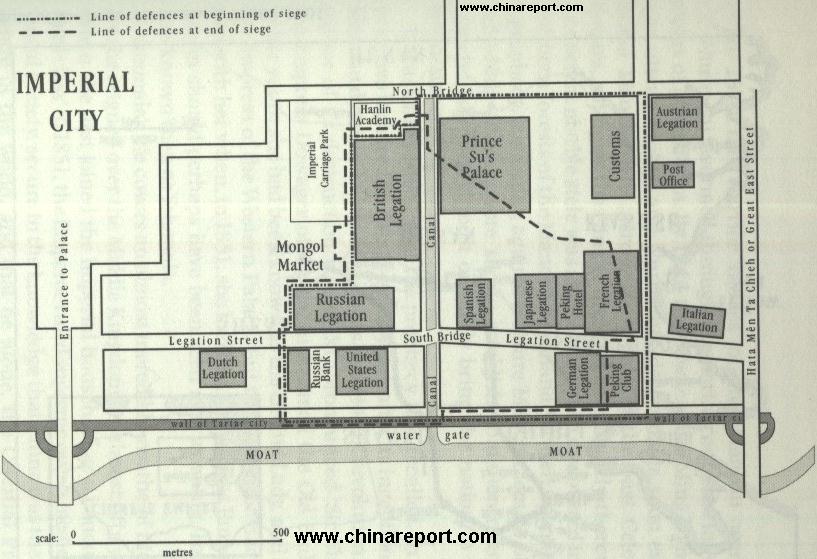Canal Street - Before the demolition of the City Walls in the 1950's, Beijing's City Wall was intersected by an Imperial Canal leading from the Imperial City in the North, through the Legations Quarter, to the City Moat outside the Wall in the South. There it connected to the Grand Canal.
The Canal was filled in in the 1950's along with the demolition of the City Wall, creating QianMen Dajie running West to East and Zheng Yi Road, running North to South and Vice Versa. The South Bridge can still be found as a hinted bulge in the road at the height of the intersection of Zheng Yi Road and Legations Street at the former Yokohama Specie Bank turned Minsheng Bank. The North Bridge has disappeared without a trace beneath the pavements of East Chang An Avenue, widened in the 1950's for the Famous Grand Military Reviews and other mass happenings.
Rue Marco Polo or "Customs Street" - Rue Marco Polo was named so by the French and was the location of the Maritime Customs Office, an office of the Chinese Government. As a result everyone but the French had named the Street Customs Street.
The Customs Office had been located in the area since the far past days of the Yuan Dynasty in Beijing (then Khanbalik), as the important trade and supply route of the Grand Canal connected to the City to the south-east, just outside the City Walls.
Taxes were levied on the grain imports to City through this Office during the Yuan Dynasty (1271 AD - 1368 AD), Ming Dynasty (1368 AD - 1644 AD) and Qing Dynasty (1644 AD - 1911 AD). Later, during the days of The Legations the Customs Office was thoroughly modernized under Leadership of (Later Sir) Robert Hart, who lived north and adjacent the Customs Office. Due to his important role in the affairs of the Legations in Beijing the Street running eastward from the Customs Office and behind the Austro-Hungarian Legations was named Rue Hart. It was the location of the British Post Office in the Legations.
Due to his large contribution to the modernizations of the Chinese State Machinery (and Coffers), his efforts in rescuing Chinese interest from western onslaught in the post-boxer war negotiations and more, the Street was the only street not "cleaned up" during political actions of the Cultural Revolution Era, leaving the Rue Hart Street sign the only such sign surviving in Beijing until this day.
Find the Former Rue Marco Polo or Customs Street, in the French claimed Eastern parts of the Legations Quarter connecting to QianMen East Street in the South, then intersecting with Legations Street, passing Rue Hart and the current Communist Party Branch of Beijing Headquarters to connect up with Chang An Avenue across from Wanfujing Street in the North.




